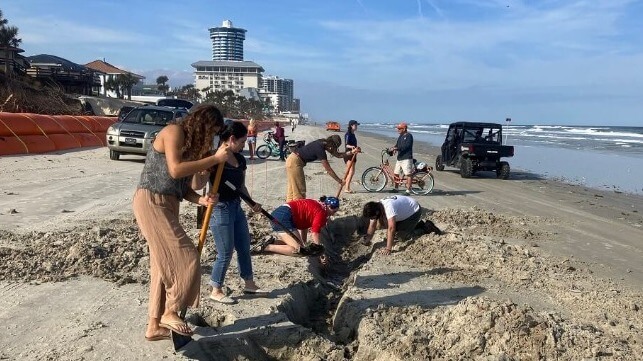Hurricane Nicole Unearthed a 19th-Century Shipwreck

The heavy wave action and storm surge of Hurricanes Ian and Nicole took a toll on the beachfront in Volusia County, Florida, and photos of the damage were distributed by news outlets around the world. But the same agitation was a boon to archaeologists. The same heavy erosion that undermined condos also dug up the remains of a previously unknown shipwreck.
The receding waters left behind a new, mysterious wooden outline in the sand, which drew considerable speculation. Popular theories for its origins ranged from bleachers left behind from the waterfront’s car-racing days (this is Daytona Beach, after all) to a wreck to a section of a pier. When the State of Florida’s underwater archaeological team arrived to inspect it, they found something different: the wooden “posts” in the ground turned out to be the worn-down ribs of a sailing ship.
The characteristics of the ship’s construction suggest that it was built in the 1800s, archaeologist Chuck Meide told local media. The statistical odds favor that timeframe as well. “If you have a random, wooden shipwreck on the beach, it’s most likely a wreck from the 1800s and that’s because there were so many more ships sailing in the 1800s than in the centuries before,” he said.
So far, the team has uncovered about 20 feet of the vessel’s estimated 100-foot length. This would be a large ship for the period, likely engaged in trading over long distances, according to Meide. Given its state and the limitations of the era’s pre-electronic recordkeeping, it may be difficult to precisely identify the vessel’s name.
The vessel’s remains will be left on the beach, packed in sand and protected from the elements. “That will help preserve it. As long as that hull is in the dark and wet, it will last a very long time, hundreds of more years,” Meide told the AP.
The last big wreck that Meide explored was the remains of a 300-ton wooden sailing ship that a storm excavated from a sand dune near St. Augustine in 2020. That vessel also had the construction characteristics of a ship from the 1800s, and while its identity is not known for sure, it could be a lost merchant vessel by the name of the Caroline Eddy.














